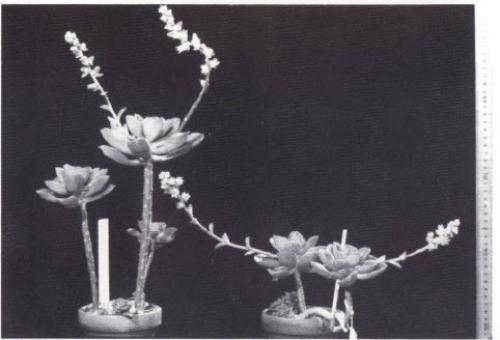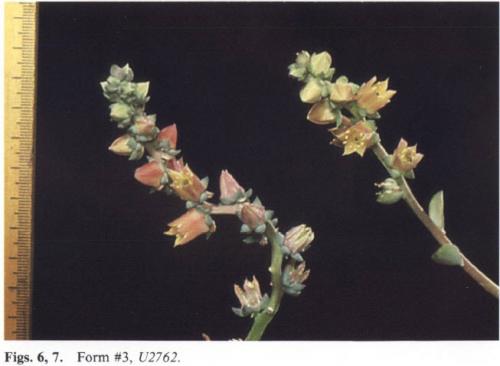Form #3
Origin : State of Mérida, southwest of Lagunillas, warm and dry, less than 700 m , the lowest and perhaps driest locality for Echeveria in Venezuela. This is not far from the type locality of E. compressicaulis and Form #3 may represent its hybrids with one of the diploid species.
Leaves also olive-brown as in Form #2, but not at all shiny, thicker and covered with tiny colorless papillae, unlike any other echeveria in Venezuela.
Description by Ch. Uhl in Cactus and Succulent Journal US 65 (2): 84-86. 1993 :
Stems of plants in cultivation up to 25 cm tall.
Rosettes of 20 - 25 leaves along the upper 3 - 4 cm.
Young leaves in cultivation green, then brownish when older.
Leaves broadly oblanceolate, with margins curving slighty upward, especially distally, up to 78 mm long, 30 mm wide and 6 mm thick at the base, conspicuously papillose, appearing almost hirtellous, although this character also appears less conspicuous in the same plants in cultivation.
Floral stems up to 27 cm, with bracts up to 20 mm long and 6 mm wide, slightly bluish glaucous and spurred.
Flowers seated directly in the axils of the fertile bracts, which are prominently spurred.
Pedicels 2 mm or less in length, with two linear bracteoles 2 - 3 mm long that sometimes dry and fall by anthesis.
Sepals nearly equal, 4 - 5 mm long and 3 - 4 mm wide, almost completely spreading.
Corolla up to 13 mm long, strongly angled, pale red outside, pale yellow inside.


Photos Charles Uhl in Cactus and Succulent Journal US 65(2): 84. 1993.